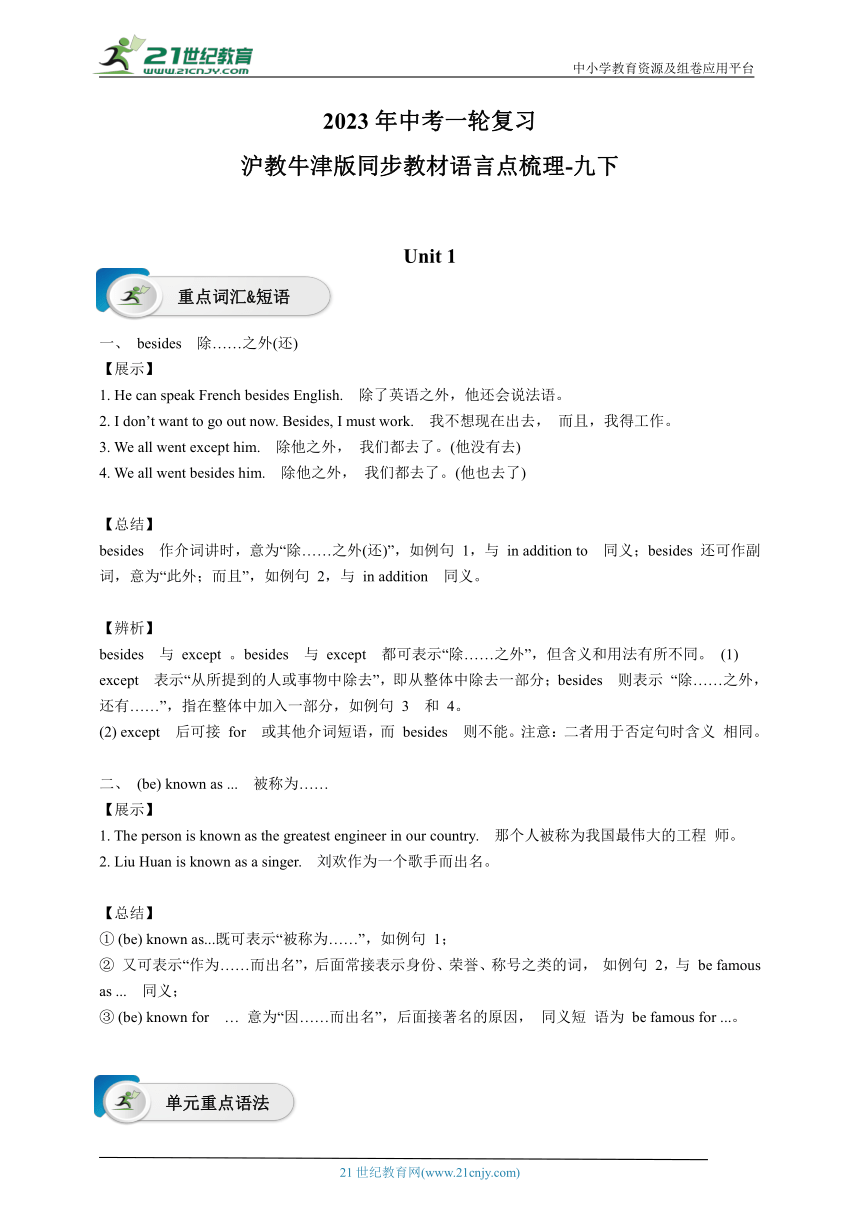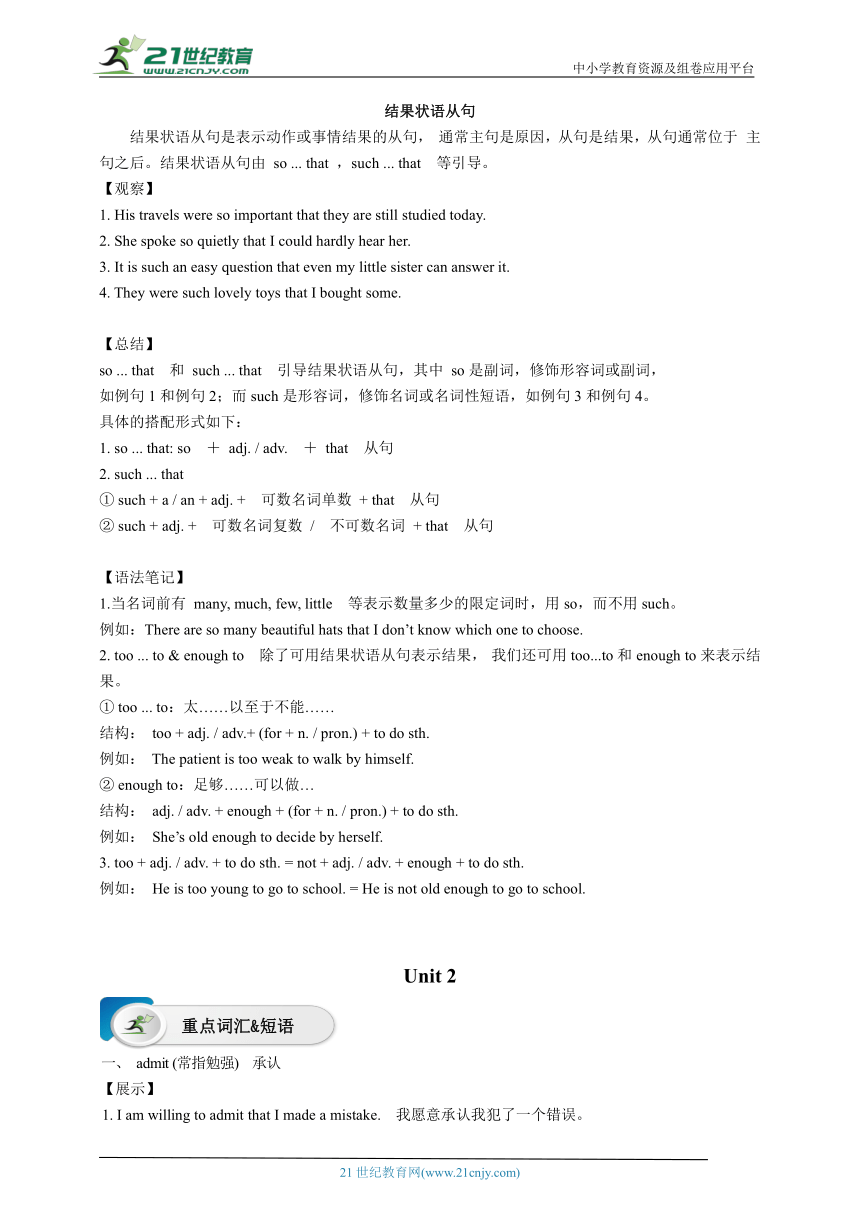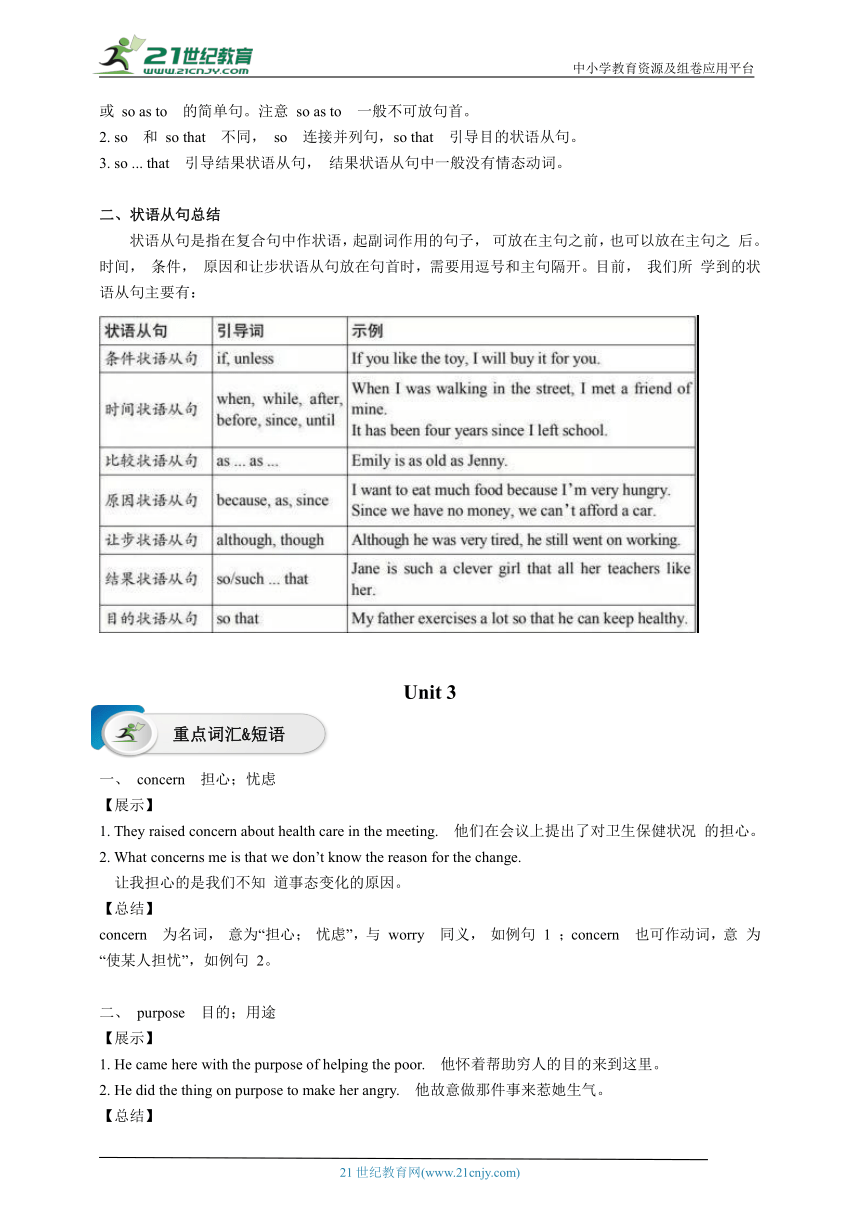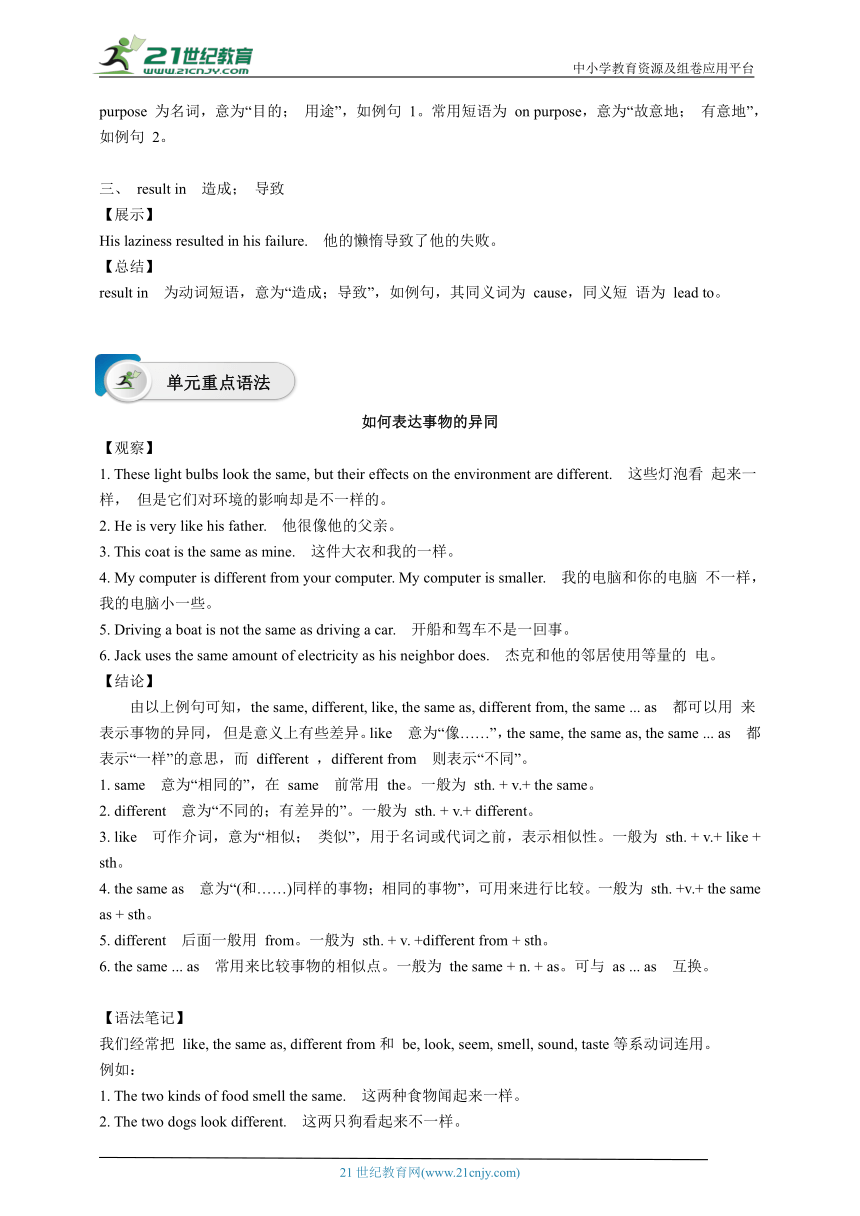2023年中考一轮复习:沪教牛津版英语九年级下册同步教材语言点梳理学案
文档属性
| 名称 | 2023年中考一轮复习:沪教牛津版英语九年级下册同步教材语言点梳理学案 |  | |
| 格式 | zip | ||
| 文件大小 | 1.4MB | ||
| 资源类型 | 试卷 | ||
| 版本资源 | 牛津深圳版 | ||
| 科目 | 英语 | ||
| 更新时间 | 2023-01-03 16:40:13 | ||
图片预览





文档简介
中小学教育资源及组卷应用平台
2023年中考一轮复习
沪教牛津版同步教材语言点梳理-九下
Unit 1
一、 besides 除……之外(还)
【展示】
1. He can speak French besides English. 除了英语之外,他还会说法语。
2. I don’t want to go out now. Besides, I must work. 我不想现在出去, 而且,我得工作。
3. We all went except him. 除他之外, 我们都去了。(他没有去)
4. We all went besides him. 除他之外, 我们都去了。(他也去了)
【总结】
besides 作介词讲时,意为“除……之外(还)”,如例句 1,与 in addition to 同义;besides 还可作副词,意为“此外;而且”,如例句 2,与 in addition 同义。
【辨析】
besides 与 except 。besides 与 except 都可表示“除……之外”,但含义和用法有所不同。 (1) except 表示“从所提到的人或事物中除去”,即从整体中除去一部分;besides 则表示 “除……之外, 还有……”,指在整体中加入一部分,如例句 3 和 4。
(2) except 后可接 for 或其他介词短语,而 besides 则不能。注意:二者用于否定句时含义 相同。
二、 (be) known as ... 被称为……
【展示】
1. The person is known as the greatest engineer in our country. 那个人被称为我国最伟大的工程 师。
2. Liu Huan is known as a singer. 刘欢作为一个歌手而出名。
【总结】
① (be) known as...既可表示“被称为……”,如例句 1;
② 又可表示“作为……而出名”,后面常接表示身份、荣誉、称号之类的词, 如例句 2,与 be famous as ... 同义;
③ (be) known for … 意为“因……而出名”,后面接著名的原因, 同义短 语为 be famous for ...。
结果状语从句
结果状语从句是表示动作或事情结果的从句, 通常主句是原因,从句是结果,从句通常位于 主句之后。结果状语从句由 so ... that ,such ... that 等引导。
【观察】
1. His travels were so important that they are still studied today. 2. She spoke so quietly that I could hardly hear her. 3. It is such an easy question that even my little sister can answer it. 4. They were such lovely toys that I bought some.
【总结】
so ... that 和 such ... that 引导结果状语从句,其中 so是副词,修饰形容词或副词,
如例句1和例句2;而such是形容词,修饰名词或名词性短语,如例句3和例句4。
具体的搭配形式如下:
1. so ... that: so + adj. / adv. + that 从句
2. such ... that ① such + a / an + adj. + 可数名词单数 + that 从句
② such + adj. + 可数名词复数 / 不可数名词 + that 从句
【语法笔记】
1.当名词前有 many, much, few, little 等表示数量多少的限定词时,用so,而不用such。
例如:There are so many beautiful hats that I don’t know which one to choose. 2. too ... to & enough to 除了可用结果状语从句表示结果, 我们还可用too...to和enough to来表示结果。
① too ... to:太……以至于不能……
结构: too + adj. / adv.+ (for + n. / pron.) + to do sth.
例如: The patient is too weak to walk by himself.
② enough to:足够……可以做…
结构: adj. / adv. + enough + (for + n. / pron.) + to do sth.
例如: She’s old enough to decide by herself.
3. too + adj. / adv. + to do sth. = not + adj. / adv. + enough + to do sth.
例如: He is too young to go to school. = He is not old enough to go to school.
Unit 2
一、 admit (常指勉强) 承认
【展示】
1. I am willing to admit that I made a mistake. 我愿意承认我犯了一个错误。
2. He admitted having seen us in the street. 他承认在街道上看到过我们。
【总结】
admit 作动词, 意为“(常指勉强) 承认”,常用搭配为“admit+ that 从句”和“admit doing sth. ”,如例句 1 和例句 2。
二、 fail 失败; 未能(做到)
【展示】
1. If you don’t work hard, you may fail. 如果你不努力工作,你可能会失败。
2. Though the doctor had tried his best, he still failed to save the girl’s life. 虽然那位医生尽了自 己最大的努力, 但是他仍未能挽救那个女孩的性命。
【总结】
fail 可以作动词,意为“失败; 未能(做到)”,如例句 1;fail to do sth. 意为“未能做某事; 做某事失败了”,如例句 2。
三、 take off 脱下
【展示】
It’s very hot here. Please take off your coat. 这里非常热。请脱下您的大衣。
【总结】
take off 意为“脱下”,如例句。它的反义词组是 put on 意为“穿上”。
【拓展】
与 take 有关的短语还有:
take in 吸收;
take up (尤指为消遣) 学着做; 开始做;
take out (从银行账户中) 提取(款);
take place 发生;
take off 起飞。
一、目的状语从句
目的状语从句用来说明事情发生的目的的,通常用 so that 来引导。
【观察】
1. You must run fast so that you can catch the bus.
2. He spoke very loudly so that the students at the back could hear him.
【结论】
由以上例句可知,so that 引导的目的状语从句中常常含 can, may, will 或 should 等情态动 词; 在谈论过去的句子里,so that 后面的动词通常 与 could, might, would 或 should 连用。
【注意】
1. 当从句的主语与主句的主语一致时,so that 引导的目的状语从句可以改写成含 in order to 或 so as to 的简单句。注意 so as to 一般不可放句首。
2. so 和 so that 不同, so 连接并列句,so that 引导目的状语从句。
3. so ... that 引导结果状语从句, 结果状语从句中一般没有情态动词。
二、状语从句总结
状语从句是指在复合句中作状语,起副词作用的句子, 可放在主句之前,也可以放在主句之 后。时间, 条件, 原因和让步状语从句放在句首时,需要用逗号和主句隔开。目前, 我们所 学到的状语从句主要有:
Unit 3
一、 concern 担心;忧虑
【展示】
1. They raised concern about health care in the meeting. 他们在会议上提出了对卫生保健状况 的担心。
2. What concerns me is that we don’t know the reason for the change.
让我担心的是我们不知 道事态变化的原因。
【总结】
concern 为名词, 意为“担心; 忧虑”,与 worry 同义, 如例句 1 ;concern 也可作动词,意 为“使某人担忧”,如例句 2。
二、 purpose 目的;用途
【展示】
1. He came here with the purpose of helping the poor. 他怀着帮助穷人的目的来到这里。
2. He did the thing on purpose to make her angry. 他故意做那件事来惹她生气。
【总结】
purpose 为名词,意为“目的; 用途”,如例句 1。常用短语为 on purpose,意为“故意地; 有意地”,如例句 2。
三、 result in 造成; 导致
【展示】
His laziness resulted in his failure. 他的懒惰导致了他的失败。
【总结】
result in 为动词短语,意为“造成;导致”,如例句,其同义词为 cause,同义短 语为 lead to。
如何表达事物的异同
【观察】
1. These light bulbs look the same, but their effects on the environment are different. 这些灯泡看 起来一样, 但是它们对环境的影响却是不一样的。
2. He is very like his father. 他很像他的父亲。
3. This coat is the same as mine. 这件大衣和我的一样。
4. My computer is different from your computer. My computer is smaller. 我的电脑和你的电脑 不一样,我的电脑小一些。
5. Driving a boat is not the same as driving a car. 开船和驾车不是一回事。
6. Jack uses the same amount of electricity as his neighbor does. 杰克和他的邻居使用等量的 电。
【结论】
由以上例句可知,the same, different, like, the same as, different from, the same ... as 都可以用 来表示事物的异同, 但是意义上有些差异。like 意为“像……”,the same, the same as, the same ... as 都表示“一样”的意思,而 different ,different from 则表示“不同”。
1. same 意为“相同的”,在 same 前常用 the。一般为 sth. + v.+ the same。
2. different 意为“不同的;有差异的”。一般为 sth. + v.+ different。
3. like 可作介词,意为“相似; 类似”,用于名词或代词之前,表示相似性。一般为 sth. + v.+ like + sth。
4. the same as 意为“(和……)同样的事物;相同的事物”,可用来进行比较。一般为 sth. +v.+ the same as + sth。
5. different 后面一般用 from。一般为 sth. + v. +different from + sth。
6. the same ... as 常用来比较事物的相似点。一般为 the same + n. + as。可与 as ... as 互换。
【语法笔记】
我们经常把 like, the same as, different from和 be, look, seem, smell, sound, taste等系动词连用。
例如:
1. The two kinds of food smell the same. 这两种食物闻起来一样。
2. The two dogs look different. 这两只狗看起来不一样。
Unit 4
一、 flood (使)灌满水;淹没
【展示】
1. The river flooded the valley. 河水淹没了河谷。
2. The heavy rain has caused floods in many parts of the country. 大雨使全国许多地方泛滥成 灾。
【总结】
flood 作动词时,意为“(使)灌满水;淹没”,如例句 1 ;flood 也可作名词, 意为“洪水, 水灾”,如例句 2。
二、 awake (使)醒来
【展示】
1. The noise awoke the sleeping baby. And he cried. 噪音惊醒了正在睡觉的婴儿。并且他哭了。
2. She was awake during the operation on her leg. 给她的腿做手术时, 她一直醒着。
【总结】
awake 可以作动词,意为“(使)醒来”,其过去式为 awoke,如例句 1 ;awake 的过去分词 为 awoken;awake 还可以作形容词, 意为“醒着的”,如例句 2。
三、 stick with 持续;坚持
【展示】
If this is your favorite job, please stick with it. 如果这是你最喜欢的工作,那就坚持下去。
【总结】
stick with 为动词短语,意为“持续; 坚持”。stick with sth.表示坚持做某事, 如例句, 同义 句型为 continue doing / with sth.。
形式主语— it
用法点击1
【观察】
1. It is already 4 o’clock now, but I have not received Lucy’s mail. 现在已经四点钟了, 但是我还没收到露西的邮件。
2. It is a long way from my home to the park. 从我家到公园有一段很长的路。
3. It’s summer now in China. 中国现在是夏季。
4. It’s very cold today. 今天很冷。
5. It’s 23 degrees today. 今天23度。
【结论】
由以上例句可知,it 用作形式主语时,可以用来指时间、距离、季节、天气、温 度, 分别 如例句 1 ,2 ,3,4 和 5。
用法点击 2
【观察】
1. He said it was hard to fix his attention on the work with so much noise. 他说有这么多噪音,他很难集中注意力工作。
2. It’s very cheap to fly there. 乘飞机去那里非常便宜。
【结论】
由以上例句可知,it 用作形式主语时,可以用来指代句子中的 to do 部分。to do 部分是真 正的主语, 而 it 只是作为形式主语。
【注意】
“It + is + 形容词 + for + 宾语 + to do sth. ”句型中通常用表示可能性、必要 性、重要性、 紧迫性、频繁程度以及价值判断等的形容词。例如:It’s impossible for him to get there in twenty minutes.他不可能在二十分钟之内到达那里。
用法点击 3
【观察】
1. It seems that you are very interested in it. 看上去你对它很感兴趣。
2. It appears that the leaders are making an important plan. 看来领导们正在制订一项重要的计 划。
【结论】
由以上例句可知,it 用作形式主语时,可以用在 it seems / appears that 句型中。that 部分是 真正的主语,而 it 只是作为形式主语。
Unit 5
一、 honest 坦率的;坦诚的
【展示】
1. Thank you for being so honest with me. 感谢你对我这么坦诚。
2. His honesty is not in question. 他的诚实是毋庸置疑的。
【总结】
honest 为形容词,意为“坦率的;坦诚 的”,如例句 1,常用搭配为 be honest with sb. / about sth. ,短语 to be honest 意为“说实在的”;honest 的名词为 honesty,意为“诚实;正直”, 如例句 2。
二、 shame 令人惋惜的事;让人遗憾的事
【展示】
1. What a shame they couldn’t come. 他们不能来真是遗憾。
2. You have shamed your family. 你使你的家庭蒙受了耻辱。
【总结】
shame 可以作名词,意为“令人惋惜的事;让人遗憾的事”,如例句 1,其同义词为 pity; shame 也可作动词,意为“使羞愧; 使丢脸”,如例句 2。
三、 (be) dying to (do sth.) 渴望(做某事);极想(做某事)
【展示】I’m dying to see my uncle. 我很想见到我叔叔。
【总结】
(be) dying to (do sth.),意为“渴望(做某事);极想(做某事)”,如例句。其同义句型为 be eager to (do sth.)。
一、时态的复习
二、被动语态的复习
【语法笔记】
不及物动词没有被动语态,例如:happen, sleep, die 和 run;情态动词也有相应的被动态
Unit 6
一、 conduct 实施;执行
【展示】
The scientist decided to conduct an experiment on the rat. 这位科学家决定在这只老鼠身上进 行一次实验
【总结】
conduct 为动词, 意为“实施;执行”,如例句。其同义短语为 carry out。
二、 force 强迫;迫使(某人做某事)
【展示】
1. His health forced him into early retirement. 他的健康迫使他提前退休。
2. The thief forced her to hand over the money.那个小偷强迫她把钱交出来。
【总结】
force 为动词,意为“强迫;迫使(某人做某事)”,如例句 1;常用搭配为 force sb. to do sth., 意为“迫使某人做某事”,如例句 2。
三、 deal with 解决;处理;应付
【展示】The matter is urgent. We must deal with it at once. 这件事情很紧急。我们必须马上处理它。
【总结】
deal with 为动词短语, 意为“解决; 处理;应付”,如例句;其同义词为 solve,同义短语 为 cope with。
一般过去时、宾语从句和 be going to
一、形容词 + that 从句
【观察】
1. She is afraid (that) her son won’t pass the Maths test.
2. I’m glad (that) she invited me to go to the movies with her.
【结论】
由以上例句可知,一些形容词之后可以跟 that 从句,有时候 that 可以省掉。有这样用法的 形容词有:afraid, glad, pleased, sorry, surprised, upset, certain, happy, sad, sure, unaware, worried 等等。
【注意】
not sure和 not certain之后可以跟 when, why, who, where, what, which 等疑问词引导的宾 语从句。
例如:
1. He is not sure when he will go to the party tomorrow.
2. He is not certain why she is angry with him.
二、宾语从句的复习
宾语从句在句子中充当宾语。接下来我们来复习一下所学的宾语从句。
【观察】
1. I believe (that) you have tried your best to do it.
2. He asked what I wanted to be in the future.
3. Can you tell me where you went last Sunday
4. I don’t know if/whether he has seen the film.
5. My teacher asked me why I was late for school.
6. The girl doesn’t know what she should do next.=The girl doesn’t know what to do next.
【结论】
由以上例句可知,that 引导的宾语从句, that 有时可以省略, 如例句 1 ;what, which, who, whom, whose 等疑问代词可以引导宾语从句,如例句 2;when, where, how, why 等疑问副词 可以引导宾语从句, 如例句 3 ;if, whether 可以引导宾语从句,如例句 4;有时候,宾语从 句之前有间接宾语结构, 如例句 5;有时候,宾语从句可以和“疑问词 + to do”结构互换, 如例句 6。
【语法笔记】
1. 宾语从句中连接词的选择: 宾语从句的连接词因为在从句中所充当的成分不同,也有所 变化, 如果在从句中充当宾语、主语,或用于修饰名词, 则用的是疑问代词;如果在从句中 充当状语, 则用的是疑问副词; 如果在从句中不充当任何成分, 则用连接词 that 或 whether/if。
2. 宾语从句的时态:
① 若主句是一般现在时,宾语从句的谓语动词可根据需要选用相应的任何时态;
② 若主句是一般过去时,宾语从句的谓语动词可根据需要选用各种表示过去的时态;
③ 若宾语从句叙述的是客观事实、普遍真理、自然现象或习惯性动作等,无论主句用什么 时态, 从句都用一般现在时。
重点词汇&短语
单元重点语法
重点词汇&短语
单元重点语法
重点词汇&短语
单元重点语法
重点词汇&短语
单元重点语法
重点词汇&短语
单元重点语法
重点词汇&短语
单元重点语法
HYPERLINK "http://21世纪教育网(www.21cnjy.com)
" 21世纪教育网(www.21cnjy.com)
2023年中考一轮复习
沪教牛津版同步教材语言点梳理-九下
Unit 1
一、 besides 除……之外(还)
【展示】
1. He can speak French besides English. 除了英语之外,他还会说法语。
2. I don’t want to go out now. Besides, I must work. 我不想现在出去, 而且,我得工作。
3. We all went except him. 除他之外, 我们都去了。(他没有去)
4. We all went besides him. 除他之外, 我们都去了。(他也去了)
【总结】
besides 作介词讲时,意为“除……之外(还)”,如例句 1,与 in addition to 同义;besides 还可作副词,意为“此外;而且”,如例句 2,与 in addition 同义。
【辨析】
besides 与 except 。besides 与 except 都可表示“除……之外”,但含义和用法有所不同。 (1) except 表示“从所提到的人或事物中除去”,即从整体中除去一部分;besides 则表示 “除……之外, 还有……”,指在整体中加入一部分,如例句 3 和 4。
(2) except 后可接 for 或其他介词短语,而 besides 则不能。注意:二者用于否定句时含义 相同。
二、 (be) known as ... 被称为……
【展示】
1. The person is known as the greatest engineer in our country. 那个人被称为我国最伟大的工程 师。
2. Liu Huan is known as a singer. 刘欢作为一个歌手而出名。
【总结】
① (be) known as...既可表示“被称为……”,如例句 1;
② 又可表示“作为……而出名”,后面常接表示身份、荣誉、称号之类的词, 如例句 2,与 be famous as ... 同义;
③ (be) known for … 意为“因……而出名”,后面接著名的原因, 同义短 语为 be famous for ...。
结果状语从句
结果状语从句是表示动作或事情结果的从句, 通常主句是原因,从句是结果,从句通常位于 主句之后。结果状语从句由 so ... that ,such ... that 等引导。
【观察】
1. His travels were so important that they are still studied today. 2. She spoke so quietly that I could hardly hear her. 3. It is such an easy question that even my little sister can answer it. 4. They were such lovely toys that I bought some.
【总结】
so ... that 和 such ... that 引导结果状语从句,其中 so是副词,修饰形容词或副词,
如例句1和例句2;而such是形容词,修饰名词或名词性短语,如例句3和例句4。
具体的搭配形式如下:
1. so ... that: so + adj. / adv. + that 从句
2. such ... that ① such + a / an + adj. + 可数名词单数 + that 从句
② such + adj. + 可数名词复数 / 不可数名词 + that 从句
【语法笔记】
1.当名词前有 many, much, few, little 等表示数量多少的限定词时,用so,而不用such。
例如:There are so many beautiful hats that I don’t know which one to choose. 2. too ... to & enough to 除了可用结果状语从句表示结果, 我们还可用too...to和enough to来表示结果。
① too ... to:太……以至于不能……
结构: too + adj. / adv.+ (for + n. / pron.) + to do sth.
例如: The patient is too weak to walk by himself.
② enough to:足够……可以做…
结构: adj. / adv. + enough + (for + n. / pron.) + to do sth.
例如: She’s old enough to decide by herself.
3. too + adj. / adv. + to do sth. = not + adj. / adv. + enough + to do sth.
例如: He is too young to go to school. = He is not old enough to go to school.
Unit 2
一、 admit (常指勉强) 承认
【展示】
1. I am willing to admit that I made a mistake. 我愿意承认我犯了一个错误。
2. He admitted having seen us in the street. 他承认在街道上看到过我们。
【总结】
admit 作动词, 意为“(常指勉强) 承认”,常用搭配为“admit+ that 从句”和“admit doing sth. ”,如例句 1 和例句 2。
二、 fail 失败; 未能(做到)
【展示】
1. If you don’t work hard, you may fail. 如果你不努力工作,你可能会失败。
2. Though the doctor had tried his best, he still failed to save the girl’s life. 虽然那位医生尽了自 己最大的努力, 但是他仍未能挽救那个女孩的性命。
【总结】
fail 可以作动词,意为“失败; 未能(做到)”,如例句 1;fail to do sth. 意为“未能做某事; 做某事失败了”,如例句 2。
三、 take off 脱下
【展示】
It’s very hot here. Please take off your coat. 这里非常热。请脱下您的大衣。
【总结】
take off 意为“脱下”,如例句。它的反义词组是 put on 意为“穿上”。
【拓展】
与 take 有关的短语还有:
take in 吸收;
take up (尤指为消遣) 学着做; 开始做;
take out (从银行账户中) 提取(款);
take place 发生;
take off 起飞。
一、目的状语从句
目的状语从句用来说明事情发生的目的的,通常用 so that 来引导。
【观察】
1. You must run fast so that you can catch the bus.
2. He spoke very loudly so that the students at the back could hear him.
【结论】
由以上例句可知,so that 引导的目的状语从句中常常含 can, may, will 或 should 等情态动 词; 在谈论过去的句子里,so that 后面的动词通常 与 could, might, would 或 should 连用。
【注意】
1. 当从句的主语与主句的主语一致时,so that 引导的目的状语从句可以改写成含 in order to 或 so as to 的简单句。注意 so as to 一般不可放句首。
2. so 和 so that 不同, so 连接并列句,so that 引导目的状语从句。
3. so ... that 引导结果状语从句, 结果状语从句中一般没有情态动词。
二、状语从句总结
状语从句是指在复合句中作状语,起副词作用的句子, 可放在主句之前,也可以放在主句之 后。时间, 条件, 原因和让步状语从句放在句首时,需要用逗号和主句隔开。目前, 我们所 学到的状语从句主要有:
Unit 3
一、 concern 担心;忧虑
【展示】
1. They raised concern about health care in the meeting. 他们在会议上提出了对卫生保健状况 的担心。
2. What concerns me is that we don’t know the reason for the change.
让我担心的是我们不知 道事态变化的原因。
【总结】
concern 为名词, 意为“担心; 忧虑”,与 worry 同义, 如例句 1 ;concern 也可作动词,意 为“使某人担忧”,如例句 2。
二、 purpose 目的;用途
【展示】
1. He came here with the purpose of helping the poor. 他怀着帮助穷人的目的来到这里。
2. He did the thing on purpose to make her angry. 他故意做那件事来惹她生气。
【总结】
purpose 为名词,意为“目的; 用途”,如例句 1。常用短语为 on purpose,意为“故意地; 有意地”,如例句 2。
三、 result in 造成; 导致
【展示】
His laziness resulted in his failure. 他的懒惰导致了他的失败。
【总结】
result in 为动词短语,意为“造成;导致”,如例句,其同义词为 cause,同义短 语为 lead to。
如何表达事物的异同
【观察】
1. These light bulbs look the same, but their effects on the environment are different. 这些灯泡看 起来一样, 但是它们对环境的影响却是不一样的。
2. He is very like his father. 他很像他的父亲。
3. This coat is the same as mine. 这件大衣和我的一样。
4. My computer is different from your computer. My computer is smaller. 我的电脑和你的电脑 不一样,我的电脑小一些。
5. Driving a boat is not the same as driving a car. 开船和驾车不是一回事。
6. Jack uses the same amount of electricity as his neighbor does. 杰克和他的邻居使用等量的 电。
【结论】
由以上例句可知,the same, different, like, the same as, different from, the same ... as 都可以用 来表示事物的异同, 但是意义上有些差异。like 意为“像……”,the same, the same as, the same ... as 都表示“一样”的意思,而 different ,different from 则表示“不同”。
1. same 意为“相同的”,在 same 前常用 the。一般为 sth. + v.+ the same。
2. different 意为“不同的;有差异的”。一般为 sth. + v.+ different。
3. like 可作介词,意为“相似; 类似”,用于名词或代词之前,表示相似性。一般为 sth. + v.+ like + sth。
4. the same as 意为“(和……)同样的事物;相同的事物”,可用来进行比较。一般为 sth. +v.+ the same as + sth。
5. different 后面一般用 from。一般为 sth. + v. +different from + sth。
6. the same ... as 常用来比较事物的相似点。一般为 the same + n. + as。可与 as ... as 互换。
【语法笔记】
我们经常把 like, the same as, different from和 be, look, seem, smell, sound, taste等系动词连用。
例如:
1. The two kinds of food smell the same. 这两种食物闻起来一样。
2. The two dogs look different. 这两只狗看起来不一样。
Unit 4
一、 flood (使)灌满水;淹没
【展示】
1. The river flooded the valley. 河水淹没了河谷。
2. The heavy rain has caused floods in many parts of the country. 大雨使全国许多地方泛滥成 灾。
【总结】
flood 作动词时,意为“(使)灌满水;淹没”,如例句 1 ;flood 也可作名词, 意为“洪水, 水灾”,如例句 2。
二、 awake (使)醒来
【展示】
1. The noise awoke the sleeping baby. And he cried. 噪音惊醒了正在睡觉的婴儿。并且他哭了。
2. She was awake during the operation on her leg. 给她的腿做手术时, 她一直醒着。
【总结】
awake 可以作动词,意为“(使)醒来”,其过去式为 awoke,如例句 1 ;awake 的过去分词 为 awoken;awake 还可以作形容词, 意为“醒着的”,如例句 2。
三、 stick with 持续;坚持
【展示】
If this is your favorite job, please stick with it. 如果这是你最喜欢的工作,那就坚持下去。
【总结】
stick with 为动词短语,意为“持续; 坚持”。stick with sth.表示坚持做某事, 如例句, 同义 句型为 continue doing / with sth.。
形式主语— it
用法点击1
【观察】
1. It is already 4 o’clock now, but I have not received Lucy’s mail. 现在已经四点钟了, 但是我还没收到露西的邮件。
2. It is a long way from my home to the park. 从我家到公园有一段很长的路。
3. It’s summer now in China. 中国现在是夏季。
4. It’s very cold today. 今天很冷。
5. It’s 23 degrees today. 今天23度。
【结论】
由以上例句可知,it 用作形式主语时,可以用来指时间、距离、季节、天气、温 度, 分别 如例句 1 ,2 ,3,4 和 5。
用法点击 2
【观察】
1. He said it was hard to fix his attention on the work with so much noise. 他说有这么多噪音,他很难集中注意力工作。
2. It’s very cheap to fly there. 乘飞机去那里非常便宜。
【结论】
由以上例句可知,it 用作形式主语时,可以用来指代句子中的 to do 部分。to do 部分是真 正的主语, 而 it 只是作为形式主语。
【注意】
“It + is + 形容词 + for + 宾语 + to do sth. ”句型中通常用表示可能性、必要 性、重要性、 紧迫性、频繁程度以及价值判断等的形容词。例如:It’s impossible for him to get there in twenty minutes.他不可能在二十分钟之内到达那里。
用法点击 3
【观察】
1. It seems that you are very interested in it. 看上去你对它很感兴趣。
2. It appears that the leaders are making an important plan. 看来领导们正在制订一项重要的计 划。
【结论】
由以上例句可知,it 用作形式主语时,可以用在 it seems / appears that 句型中。that 部分是 真正的主语,而 it 只是作为形式主语。
Unit 5
一、 honest 坦率的;坦诚的
【展示】
1. Thank you for being so honest with me. 感谢你对我这么坦诚。
2. His honesty is not in question. 他的诚实是毋庸置疑的。
【总结】
honest 为形容词,意为“坦率的;坦诚 的”,如例句 1,常用搭配为 be honest with sb. / about sth. ,短语 to be honest 意为“说实在的”;honest 的名词为 honesty,意为“诚实;正直”, 如例句 2。
二、 shame 令人惋惜的事;让人遗憾的事
【展示】
1. What a shame they couldn’t come. 他们不能来真是遗憾。
2. You have shamed your family. 你使你的家庭蒙受了耻辱。
【总结】
shame 可以作名词,意为“令人惋惜的事;让人遗憾的事”,如例句 1,其同义词为 pity; shame 也可作动词,意为“使羞愧; 使丢脸”,如例句 2。
三、 (be) dying to (do sth.) 渴望(做某事);极想(做某事)
【展示】I’m dying to see my uncle. 我很想见到我叔叔。
【总结】
(be) dying to (do sth.),意为“渴望(做某事);极想(做某事)”,如例句。其同义句型为 be eager to (do sth.)。
一、时态的复习
二、被动语态的复习
【语法笔记】
不及物动词没有被动语态,例如:happen, sleep, die 和 run;情态动词也有相应的被动态
Unit 6
一、 conduct 实施;执行
【展示】
The scientist decided to conduct an experiment on the rat. 这位科学家决定在这只老鼠身上进 行一次实验
【总结】
conduct 为动词, 意为“实施;执行”,如例句。其同义短语为 carry out。
二、 force 强迫;迫使(某人做某事)
【展示】
1. His health forced him into early retirement. 他的健康迫使他提前退休。
2. The thief forced her to hand over the money.那个小偷强迫她把钱交出来。
【总结】
force 为动词,意为“强迫;迫使(某人做某事)”,如例句 1;常用搭配为 force sb. to do sth., 意为“迫使某人做某事”,如例句 2。
三、 deal with 解决;处理;应付
【展示】The matter is urgent. We must deal with it at once. 这件事情很紧急。我们必须马上处理它。
【总结】
deal with 为动词短语, 意为“解决; 处理;应付”,如例句;其同义词为 solve,同义短语 为 cope with。
一般过去时、宾语从句和 be going to
一、形容词 + that 从句
【观察】
1. She is afraid (that) her son won’t pass the Maths test.
2. I’m glad (that) she invited me to go to the movies with her.
【结论】
由以上例句可知,一些形容词之后可以跟 that 从句,有时候 that 可以省掉。有这样用法的 形容词有:afraid, glad, pleased, sorry, surprised, upset, certain, happy, sad, sure, unaware, worried 等等。
【注意】
not sure和 not certain之后可以跟 when, why, who, where, what, which 等疑问词引导的宾 语从句。
例如:
1. He is not sure when he will go to the party tomorrow.
2. He is not certain why she is angry with him.
二、宾语从句的复习
宾语从句在句子中充当宾语。接下来我们来复习一下所学的宾语从句。
【观察】
1. I believe (that) you have tried your best to do it.
2. He asked what I wanted to be in the future.
3. Can you tell me where you went last Sunday
4. I don’t know if/whether he has seen the film.
5. My teacher asked me why I was late for school.
6. The girl doesn’t know what she should do next.=The girl doesn’t know what to do next.
【结论】
由以上例句可知,that 引导的宾语从句, that 有时可以省略, 如例句 1 ;what, which, who, whom, whose 等疑问代词可以引导宾语从句,如例句 2;when, where, how, why 等疑问副词 可以引导宾语从句, 如例句 3 ;if, whether 可以引导宾语从句,如例句 4;有时候,宾语从 句之前有间接宾语结构, 如例句 5;有时候,宾语从句可以和“疑问词 + to do”结构互换, 如例句 6。
【语法笔记】
1. 宾语从句中连接词的选择: 宾语从句的连接词因为在从句中所充当的成分不同,也有所 变化, 如果在从句中充当宾语、主语,或用于修饰名词, 则用的是疑问代词;如果在从句中 充当状语, 则用的是疑问副词; 如果在从句中不充当任何成分, 则用连接词 that 或 whether/if。
2. 宾语从句的时态:
① 若主句是一般现在时,宾语从句的谓语动词可根据需要选用相应的任何时态;
② 若主句是一般过去时,宾语从句的谓语动词可根据需要选用各种表示过去的时态;
③ 若宾语从句叙述的是客观事实、普遍真理、自然现象或习惯性动作等,无论主句用什么 时态, 从句都用一般现在时。
重点词汇&短语
单元重点语法
重点词汇&短语
单元重点语法
重点词汇&短语
单元重点语法
重点词汇&短语
单元重点语法
重点词汇&短语
单元重点语法
重点词汇&短语
单元重点语法
HYPERLINK "http://21世纪教育网(www.21cnjy.com)
" 21世纪教育网(www.21cnjy.com)
